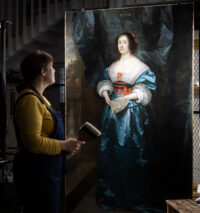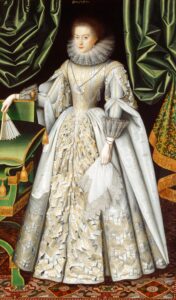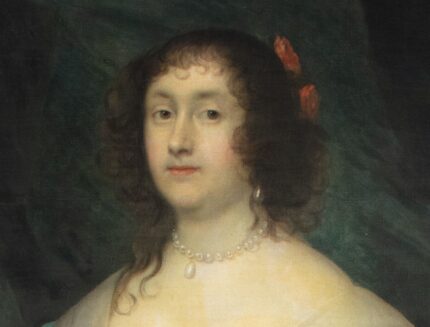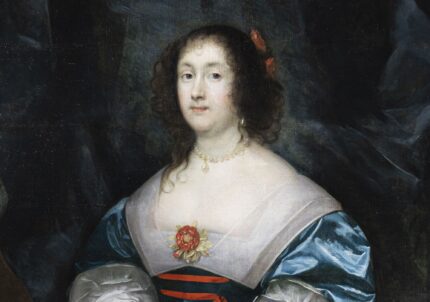 Restoration of a 17th century portrait of Diana Cecil, great-granddaughter of Queen Elizabeth I’s chief advisor William Cecil, has revealed her original thin upper lip and high forehead, removing the overpaint that had artificially plumped her pucker and lowered her hairline. The conservation also revealed the signature of the artist and the date hidden in the folds of the curtain: Cornelius Johnson, 1634.
Restoration of a 17th century portrait of Diana Cecil, great-granddaughter of Queen Elizabeth I’s chief advisor William Cecil, has revealed her original thin upper lip and high forehead, removing the overpaint that had artificially plumped her pucker and lowered her hairline. The conservation also revealed the signature of the artist and the date hidden in the folds of the curtain: Cornelius Johnson, 1634.
 The portrait is one of two of Diana Cecil in The Suffolk Collection, a group of 400 works, many portraits of aristocrats and royals but also other masterpieces by the likes of Vermeer, Turner and Rembrandt, amassed by the Howard family from the 17th to the 20th century. Diana’s sister Elizabeth was married to a Howard, which is how the portraits came to be in the collection. The greatest portraits of The Suffolk Collection are nine full-length pieces by the premiere Jacobean portraitist William Larkin, one of which is a 1614 portrait of Diana Cecil painted when she was about 15 years old. Her high forehead and fine upper lip are in evidence even at that young age.
The portrait is one of two of Diana Cecil in The Suffolk Collection, a group of 400 works, many portraits of aristocrats and royals but also other masterpieces by the likes of Vermeer, Turner and Rembrandt, amassed by the Howard family from the 17th to the 20th century. Diana’s sister Elizabeth was married to a Howard, which is how the portraits came to be in the collection. The greatest portraits of The Suffolk Collection are nine full-length pieces by the premiere Jacobean portraitist William Larkin, one of which is a 1614 portrait of Diana Cecil painted when she was about 15 years old. Her high forehead and fine upper lip are in evidence even at that young age.
Diana Cecil was considered one of the great beauties of the Jacobean nobility. She married twice, first to Henry de Vere, 18th Earl of Oxford, in 1624, barely a year before his death, and again in 1629 to Thomas Bruce, who would be created 1st Earl of Elgin by King Charles I in 1633. The newly-restored portrait of Diana was made the year after her husband received that rich favor.
In the later portrait, Cecil wears a fashionable blue satin bodice and full, trailing skirt. In contrast to the earlier portrait, elite fashion is characterised by understated elegance, rather than opulently patterned fabric or complicated layering, English heritage said.
Plain silk, satin or taffeta were the height of fashion, with one or two focal points, such as the red ribbons laced across the front of Cecil’s bodice, holding the stomacher in place, and a matching red rose at her breast and a patterned fan, which she holds half-open in front of her.
The Suffolk Collection is displayed at Kenwood House, a stately neoclassical villa in Hampstead administered by English Heritage. The later portrait of Diana Cecil recently underwent conservation so that it could be put on display. It had suffered significantly from having been rolled up widthways, damaging the paint surface, and old varnish had yellowed, dimming the once-brilliant colors. The removal of the old varnish uncovered the touch-ups to her lips and hair, likely made in the late 19th or early 20th century in a failed attempt to repair some of the damage from the rolling and update her looks in keeping with beauty standards of the time while they were at it.
Alice Tate-Harte, collections conservator (fine art) at English Heritage, said in a press release: “As a paintings conservator I am often amazed by the vivid and rich colours that reveal themselves as I remove old, yellowing varnish from portraits, but finding out Diana’s features had been changed so much was certainly a surprise!
“While the original reason for overpainting could have been to cover damage from the portrait being rolled, the restorer certainly added their own preferences to ‘sweeten’ her face. I hope I’ve done Diana justice by removing those additions and presenting her natural face to the world.”
The restored portrait of Diana Cecil will go on display next to the portrait of her second husband Thomas Bruce at Kenwood House on November 30th.

